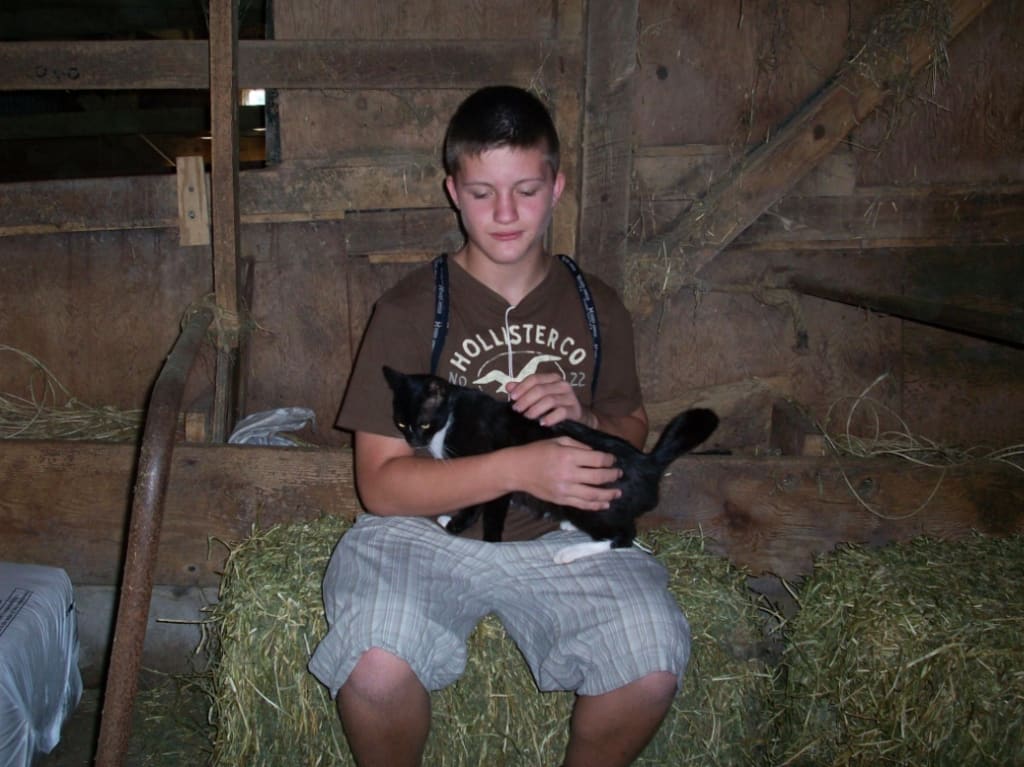Trains, Cornfields, Animals, and Barns
Pennsylvania has something for everyone.

One of the marketable traits of Florida is the excessive warmth with which we
live all year round. Apparently, it gets mighty cold in other states. Time for a summer road trip! The farther north we traveled, the stranger the signs became. As we passed through north Florida, we saw signs warning us that the road may become icy during winter. I sure hope it doesn’t get icy in the summer. In South Carolina, the signs said, “Bridge Freezes Before Road.” Vaguely threatening. Farther to the north, the signs warned of more frigid pavement. I’m surprised we didn’t come across signs that said, “Danger-Road Still Frozen from Last Year.”
Another problem with the roads signs we encountered were the choices of destinations. For example, somewhere in Virginia there’s be a sign indicating the way to New York City. (On the trip south, there were signs in Virginia that told bewildered drivers how many miles to Miami.) I suppose we should accept any entry on a sign, we who come from the state where “Perry” appears on most signs on US 19. Rumor is that one of the contractors working on those signs hailed from Perry, and so that tiny blot of a town appears on most signs when no one really knows anything about that God-forsaken little town in the armpit of Florida.
Cars aren’t the only travel options. Railroads are a big hobby for Pennsylvania people. Many public parks and amusement areas feature prominently some kind of miniature railroad with different gauge tracks and cars. My husband’s family knows more than a handful of people who have these huge railroads built around their property just for fun. My father-in-law has a railroad collection in the basement that amazes my oldest son Adam each time we visit. We visited the Strasburg Railroad, which boasts the oldest running steam engine in the country. Last year we took the one-hour ride on the railroad that circled the entire town. We heard ghost whistles from a nonexistent train that were rather spooky as we went through dark forests. We passed a ginormous Corn Maze, which was a multi-acre field of corn planted in a way that it becomes a life-size maize maze. People would pay a nominal fee to try to make it through the maze. From the elevated tracks we could see the people trying to make it through, getting stuck at dead ends. Outposts were set up to find the people who became hopelessly lost in the corn. This was pre-cell phone and GPS. Of course, the day we visited the train station there was an even bigger attraction: Thomas the Tank was there. The real one. With the creepy face and everything. There was a midway set up with fun and games and food for the kids. We have a cherished photograph of our Wade with Thomas because he was in his train phase. The day was wicked hot, so we kept the visit short. We came away with engineer caps, train stickers, and a train whistle. That train whistle, however, mysteriously disappeared on the drive home.
I will never take driving in Florida for granted again. At least not driving in a flat, familiar town. Pennsylvania is full of hilly and mountainous driving, and all the locals are quite used to it. I am not. Having a van with an automatic transmission, I’m not used to downshifting to 3rd gear to make it up a hill. My transmission was screaming in agony most of the time because I kept forgetting to downshift every so often. There are other pitfalls to encounter driving in this part of the country. One problem I found involves the road name signs, or lack thereof. Since my husband knows the territory quite well, he doesn’t need road signs. I, however, tried to venture out on my own with written directions. “Turn right by the Stoltzfus cornfield, then make a left at the Dietz cornfield.” Problem was there were cornfields everywhere. I was terrified of becoming lost, hysterically sobbing to some Amish farmer that I can’t find my way home.
Luckily, I did not get lost that summer. I avoided all the “road remnants” like little brown land mines left behind from the Amish buggies and didn’t hit any of them. With a giant orange triangle on the back of the buggies, they were hard to miss. Neither did I get a ticket, which is phenomenal because of the number of speed traps in the area. This place rivals Waldo in the number of “reduced speed zones.” Just outside the farming area in downtown Lancaster there is road construction that has been going on for at least five years, and the locals are not happy. This is, I believe, where road rage originated. Worse when a buggy needed to use the road. The Pennsylvania DOT has erected signs that say, “Slow down - My Mommy works here,” and the equivalent for the Daddy. Must be bad if they play the sympathy card to get drivers to slow down.
After classic cars and trains, pets were a universal love across this great state, and in Pennsylvania, everyone had a pet. I think most Pennsylvania Dutch were dog people, but there were quite a few people that could have made an argument for cats. In the farming life, animals played a vital role in the function of the farm’s day-to-day activities. Horses pulled farming implements and buggies. Cats kept the rodent population down around the grain silos. Cows provided milk and meat. Chickens provided eggs and meat. Dogs provided companionship, safety, and entertainment.
Even in the unbearable heat, I saw farmers out in the field with their dogs running along, accompanying them. Most of the dogs up here are big dogs; my father-in-law had a white Labrador retriever named Molly. Most of the animals were working animals; they either hunted, pulled plows or buggies, provided food, or watched over the family. Beagles and hounds were also popular up there.
One of my husband’s relatives lived on real working farm. That drew a lot of attention from my sons, who were always looking for a new adventure. First, we tried to keep them away from the cats. Cats are invaluable on a farm because they were excellent mousers. However, some of these cats were older than dirt and remained outdoor pets. They had quite the nasty temper. Perfect attraction for the boys, of course. Then we met the goat. Billy the Goat was tied up on a long rope, and he had a reputation of being mean and feisty. I bravely told my sons I would hold him by the collar so he and his brother could visit their cousins at the top of the hill. He was the Billy Goat Gruff we had to pass to go up the winding path to their aunt’s house. As I got a couple of feet closer to the animal, the goat lunged out of the barn where he was hiding and jumped toward me. I leaped up and backwards, Matrix-like, running over both my boys and nearly twisted the ankles off my feet. Nothing better than demonstrating mature caution to my kids, right? That goat was truly possessed.
Next, we saw the horse (HOR-hee, according to Wade) who supposedly bites. Not Wade, the horse. I certainly wasn’t going to test that one out after the goat incident. The cows were munching placidly on grass, nibbling on the weeds with their teeth, and of course one animal had to go potty right in front of us. Just a little extra the boys could talk about in the van for HOURS at a time. We saw the corn which was starting to grow a little sideways from all the rains there. Amish farmers leased the land to plow, plant, and harvest the corn. This corn was fodder for the animals during the wintertime when the snows and ice prevent anything from growing. It’s much different from summer sweet corn. This is something Floridians forget about. Farming is a hard job, from sunup to sundown, but experiencing it made me appreciate the foods I buy in the comfortable air-conditioned grocery store. Many people work long hard hours so I can have fresh milk, broccoli, and carrots on the table.
A pair of HOR-hees stayed in the barn when the sun was baking. Because of the animal poop in the stalls, there were tons of flies. The boys kept swatting at them (and each other), but it did no good. They spotted the barn cats, and off they went running after them. If you’ve ever met a barn cat, you know the futility of that endeavor. Up above in the rafters the swallows built their nests and made awful noises. Those birds could be territorial and mean. This barn was built in the 1930s, and was repaired over the years with new gates, roofs, wood to replace the slats that made up the fence, additional stalls. There were old bridles and reins, saddles, and saddle quilts hanging up, covered in cobwebs, unused for years. The animals weren’t ridden anymore; they had the chance to relax in their waning years.
Cleaning the barn was something my husband distinctly remembered as a boy when he was helping his grandfather. The smelly horse and goat poop had to be scooped up and carted off; it would be sold to the Amish as natural fertilizer. Pitchforks were used to unroll the new hay to be set down as bedding and as a supplement to the horses’ diet. He remembered another part of the barn that always amazed him; in one of the unused sections near the front was an ancient Indian motorcycle that had been there since the 1940s when his grandfather went to war. The motorcycle was never ridden again but always remained in my husband’s memories. Maybe one day he’d inherit it.
On the front of the barn was a round hex sign under the gable. In Pennsylvania Dutch folklore, the hex signs of six-pointed stars kept evil spirits away from the animals (in a barn) and people (in a house). The shape and design of the hex signs varied; they were often used as patterns on Amish quilts. The front of the barn still had peeling remnants of red paint which was used to protect the non-pressure-treated wood.
The idea of an Amish barn-raising is a real thing. These hard-working people would build one in a day or two, usually after a tornado or windstorm knocked them down. Everyone in their community came together to support one another because the barns were their livelihood. The horses that pulled the farm equipment needed a place for the wintertime, and the dairy cows needed a place for milking. We learned how these people, known as the Plain people, live very simply, following the same traditions for over 300 years. The only thing that changed over the years is that Amish barns are now wired with electricity, but not for lighting. It’s to keep the cow milk at a safe temperature before it’s put into the trucks.
After two weeks of Pennsylvania hospitality (shoo-fly pie, anyone?), we headed home. When we left two weeks earlier, the minivan was in pristine condition: now -goldfish everywhere, mixed in with crushed pretzels and some orange “circus peanuts,” toys scattered everywhere, fast-food bags and cups from no less than five different places, reddish orange dirt, nose prints on the windows, magic marker markings of hex signs and HOR-hees, French fries stuck here there and everywhere, strange odors emanating from the very heart of the vehicle, bags in disarray like a thief had picked through them. Is this blood? Oh, just ketchup.
Can’t wait to see what adventures we encounter the next time we head up north.
About the Creator
Barb Dukeman
After 32 years of teaching high school English, I've started writing again and loving every minute of it. I enjoy bringing ideas to life and the concept of leaving behind a legacy.






Comments
There are no comments for this story
Be the first to respond and start the conversation.